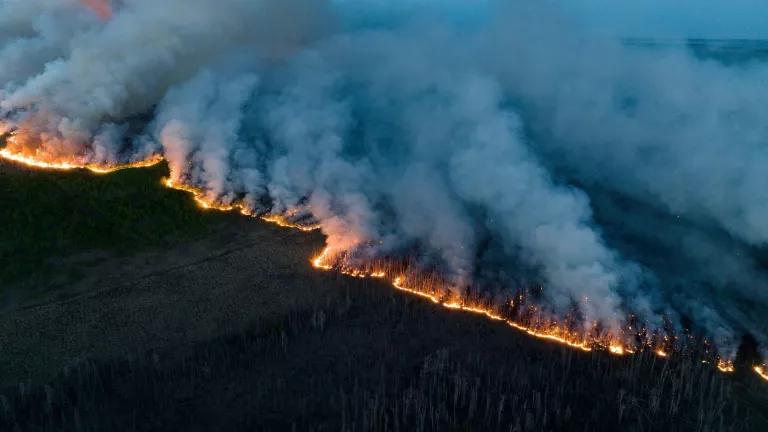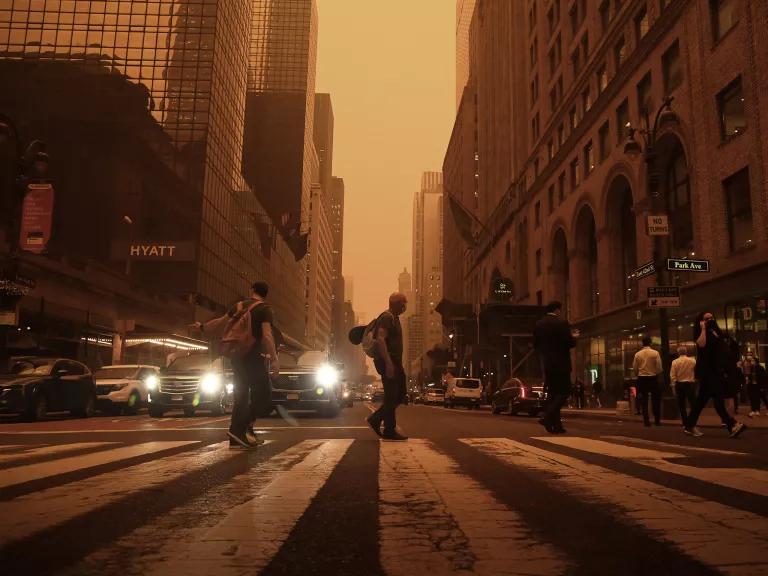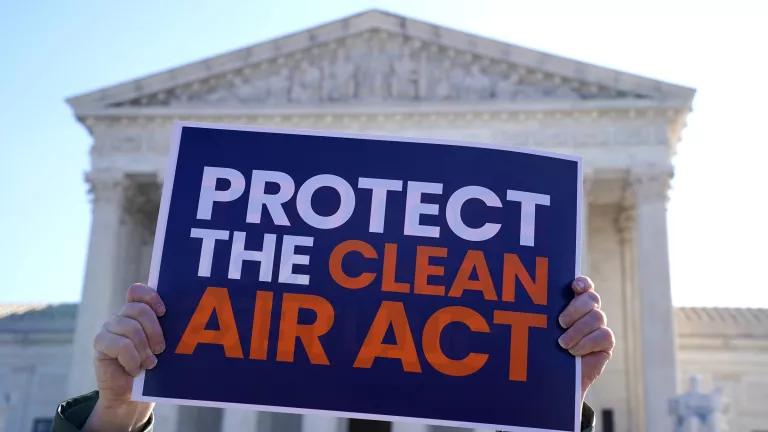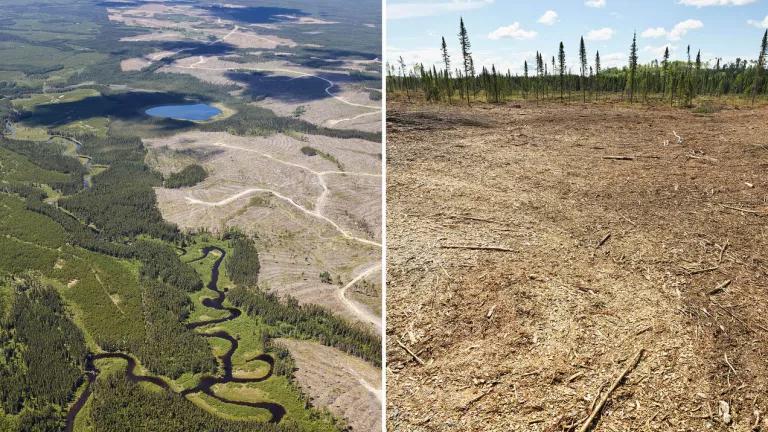Questions Answered on Canadian Wildfires—a Public Health Threat Linked to Climate Change
Here is some key information that may help us prepare for the future and address the fossil fuels at the root of the problem.

Aerial photo shows wildfires burning in northeastern region of British Columbia, Canada, on June 9, 2023.
Xinhua/Alamy
Climate change is fueling longer and stronger wildfire seasons, and as we've seen vividly this past week, smoke can travel far downwind and afflict areas far larger than the burned regions.
The science is clear: Because of climate change, we’re seeing hotter days, drier conditions, and earlier spring snowmelt that puts more wildfire fuel in play earlier and extends the wildfire season—all of these are converging factors. Smoke exposure is dangerous because microscopic particles can enter our bloodstream and damage the heart, lungs, and brain.
In recent years, smoke exposure has been linked to thousands of emergency department visits, hospitalizations, and early deaths across the country—triggering billions of dollars in health-related costs. It's reasonable to expect that wildfire smoke, already a serious threat to clean air gains over the past half century, is going to increase as a serious public health concern in the coming years.
The fires in Canada have, so far, torched enough land to cover half the state of Indiana. Smoke caused widespread “code reds” for air quality across much of the United States.
Because this situation is so unprecedented, many people have questions about climate change, wildfires, smoke exposures, and how this all affects their health. Here are some answers to key questions about the Canadian wildfires that may help us prepare for the future and address the fossil fuels at the root of the problem.
What’s the latest on the Canadian wildfires?
As of Monday, wildfires have burned 11.9 million acres of Canadian forests. That’s enough to cover half the state of Indiana. It’s more than 10 times Canada’s average for this time of year.
What is the United States doing to help?
President Biden has sent more than 600 U.S. firefighters and support personnel to help fight the Canadian fires. Other countries sending firefighters to Canada including Australia, France, New Zealand, and South Africa.
How long will this last?
The fires show no sign of abating. As of Monday, 449 major fires were actively burning across Canada, including 219 that are burning out of control. Many have been burning for weeks.
What about the smoke in the United States?
While skies have largely cleared over much of the country, future conditions will vary with winds and weather so long as the massive fires continue to burn. The smoke-forecasting website BlueSky Canada projects moderate levels of smoke and haze pouring into the northeastern United States and across the Great Lakes and into the Midwest this week.
How does this compare to the U.S. wildfire situation?
So far this year, wildfires have burned 19 times more land across Canada (11.9 million acres) than the United States (628,710 acres).
Across the United States, wildfires have burned roughly half (52 percent) the average area—1,204,674 acres—that had been burned by this time each year. Rapid snowmelt and spring rains muted early wildfire risks across much of California and the Southwest.
Going forward, much of Alaska, parts of the Pacific Northwest, the Great Lakes region, and parts of the far Northeast are seen as high-risk areas for summer wildfires.
Is Canada’s situation unprecedented?
Canada is on track to have its worst wildfire season on record, with hundreds of large fires blazing out of control across the length of the country, from British Columbia to Nova Scotia. There’s no recorded precedent for so much of the United States to be enveloped in this much smoke from Canadian wildfires, which prompted public health alerts that affected millions of people. This isn’t the first time that wildfire smoke has traveled cross-country, making it dangerous to breathe in places hundreds of miles from the blaze. Nor is this the only country to be blanketed by wildfire smoke plumes large enough to be tracked from space.

Smoke from the wildfires in Canada shrouds New York City on June 7, 2023.
Marc A. Hermann/MTA
What are the health risks of breathing air polluted by smoke from wildfires?
Smoke from wildfires contains tiny particles a 30th the width of human hair, small enough to be absorbed by human lungs and then the bloodstream. With enough exposure, these particles can irritate the eyes and throat, aggravate asthma, decrease lung function, inflame airways, trigger nonfatal heart attacks, and even cause premature death in those with existing lung or heart disease. At one point last week, air in New York City contained 11 times more of this small particulate matter than is considered safe by the U.S. Environmental Protection Agency (EPA).
What’s the connection between wildfires and climate change?
No single fire is directly caused by climate change. Warming temperatures, extended droughts, and other consequences of climate change can, however, turn a forest into a tinderbox, making for longer and more active wildfire seasons and creating the conditions for forests to burn, and fires to spread, faster than they would otherwise.
“Climate change is loading the dice,” reports the U.S. National Oceanic and Atmospheric Administration, “transforming what was once a natural, cyclical, and seasonal visitor on the landscape into an omnipresent threat.”
How is climate playing out in these fires in Canada?
Warmer temperatures and less precipitation than normal turned much of Canada’s native forestland into a tinderbox this spring, creating the conditions for these calamitous fires. Large swaths of Canada, specifically Alberta and Saskatchewan, have experienced abnormally dry conditions and even drought for much of the year. Western Canada received less winter snowfall than usual. And much of the country experienced its warmest May on record, with temperatures soaring up to 12 degrees Fahrenheit above average in places. In Halifax last week, temperatures hit 18 degrees Fahrenheit above average, along with record-breaking seasonal highs in major cities like Montreal, Ottawa, and Toronto.
What, in a nutshell, is driving the climate crisis?
Just since 1990, we’ve burned more coal, gas, and oil than in all of history before that, raising the amount of carbon dioxide in the atmosphere by 20 percent, its highest level in at least 3.6 million years. That carbon pollution, along with other greenhouse gas pollution from human activity, is trapping 49 percent more heat in the earth’s atmosphere than in 1990.
What are the results?
Over the past century, we’ve warmed the earth about 1.1 degrees Celsius, or 2 degrees Fahrenheit. The 10 hottest years on record have all occurred since 2010.
We’re seeing the consequences all around us. Last year alone, extreme weather and climate disasters did $175 billion worth of damage across the United States, killing 474 people. Seas are rising. Species are in collapse. Ocean heat waves have doubled since 1980. Hurricanes are lasting longer and penetrating more deeply inland. Coral reefs are dying. The Gulf Stream is slowing down. The Colorado River is drying up. And globally, climate change and land use shifts are on track to increase extreme wildfires like those in Canada by up to 14 percent by 2030, a recent United Nations report projects.
What can we do about it?
The science is clear: We’ve got to cut the carbon pollution from burning coal, gas, and oil nearly in half compared to 2010 levels, by 2030, and stop adding it to the atmosphere altogether, on balance, by 2050, to avert a climate catastrophe. That means phasing out fossil fuels and shifting toward cleaner ways to power our future by, for example, getting more clean electricity from the wind and sun; making our homes and workplaces more energy efficient; switching to electric vehicles; and building a modern and reliable power and storage grid.
Where does this pollution come from and how can we reduce it?
The largest sources of carbon pollution are the transportation sector—mostly cars and trucks—and power plants that burn coal and gas. Together, these sources account for about half of the nation’s greenhouse gas emissions. In April, the EPA proposed new rules to cut carbon emissions from cars and trucks. Those rules are being finalized. Public comments may be submitted to the agency here. In May, the agency proposed new standards to reduce carbon pollution from power plants. The EPA is working to finalize those rules. Public comments may be submitted here.




